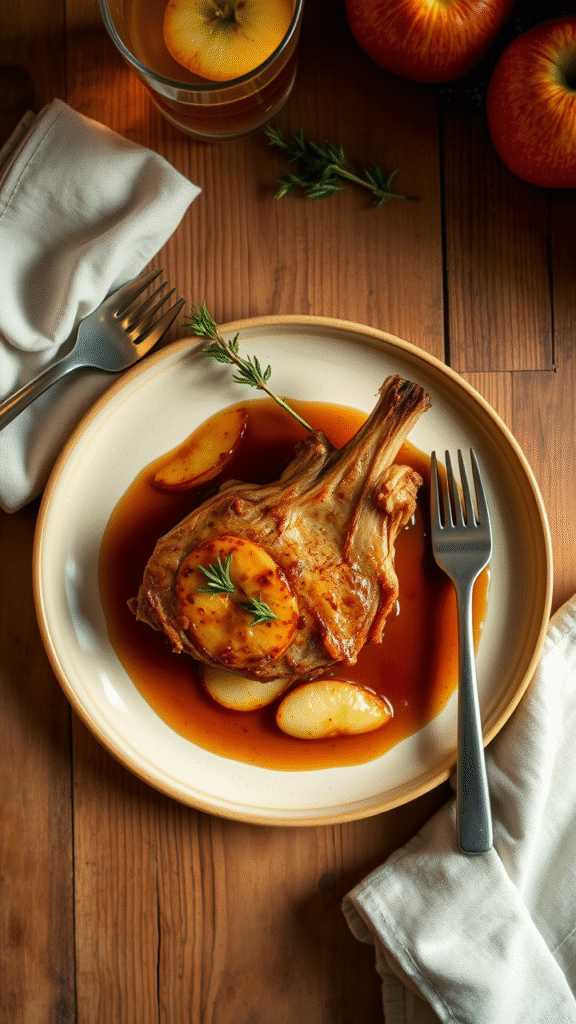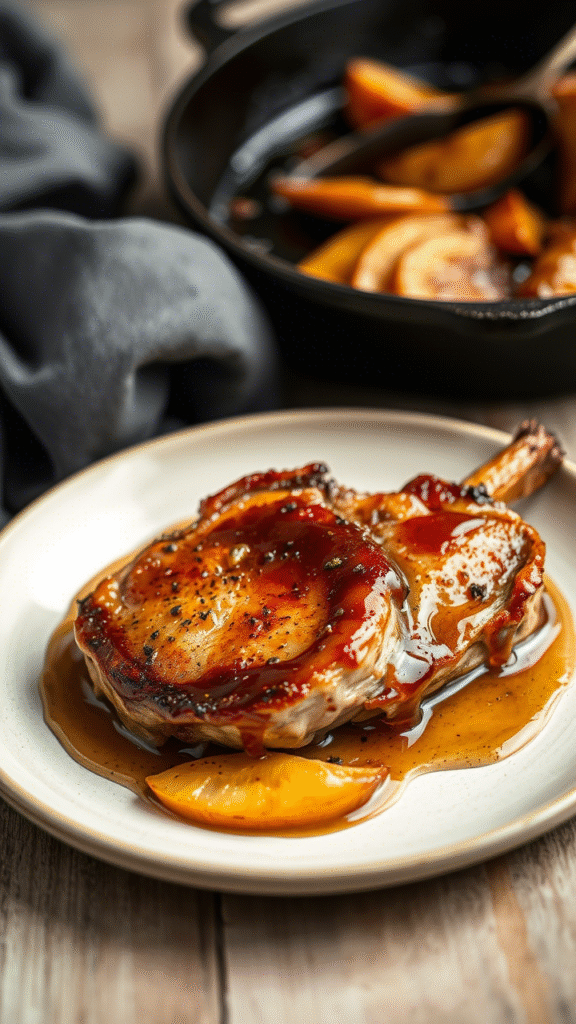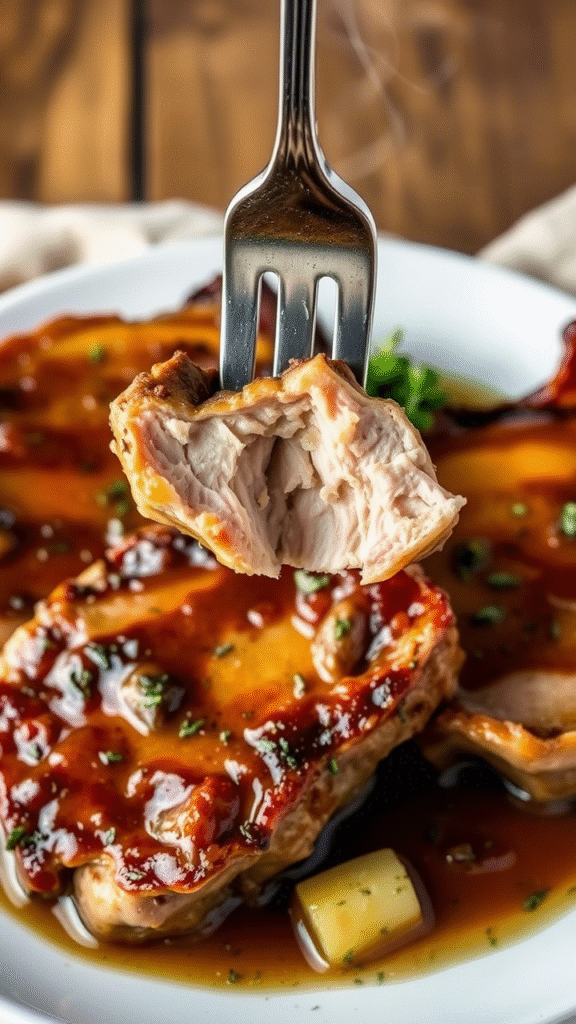Let me tell you, I first made cider-braised pork chops by accident. Totally winged it. I had dry pork, half a bottle of leftover cider from the night before, and a need to not waste food. What happened next? Pure alchemy. The apples, the tang, that rich-savory gravy—it was like fall had snuck into my skillet. It was supposed to be dinner, but it felt like a revelation.
This dish is one of those quiet showstoppers. It’s humble. Not flashy. But when done right, it tastes like something your great-grandmother made—with a bit of modern technique tucked behind the flavor. We’re talking seared bone-in chops, gently braised in hard apple cider, with shallots, mustard, a whisper of thyme, and just enough butter to make it luxurious.
There’s depth here. Sweet, savory, acidic, and unctuous all at once. It’s comfort food that doesn’t feel lazy. It’s simple, but not basic. And when you understand the science and soul behind it, it’ll change how you look at pork chops forever.
Ingredients & Substitutions

For the Pork Chops:
- 4 bone-in pork chops, about 1 to 1.25 inches thick
- Kosher salt and freshly cracked black pepper
- 2 tablespoons neutral oil (canola, grapeseed, or sunflower)
For the Braise:
- 1 large shallot, thinly sliced (or ½ small yellow onion, if you’re in a pinch)
- 2 garlic cloves, smashed—not minced, smashed
- 1 tablespoon Dijon mustard (or whole grain if you want texture)
- 1 teaspoon fresh thyme leaves (dried works too, but reduce to ½ tsp)
- 1 cup hard apple cider (not apple juice—real cider, dry if possible)
- ½ cup low-sodium chicken stock
- 1 tablespoon apple cider vinegar
- 2 tablespoons unsalted butter (add more if you’re feeling rebellious)
Optional but Highly Recommended:
- 1 crisp apple, thinly sliced (think Honeycrisp or Pink Lady)
- A splash of cream at the end, just a touch
- Crusty bread for serving or mashed potatoes if you’re going full throttle
Ingredient Insights:
Let’s talk chops. Bone-in is non-negotiable here. The bone adds flavor and protects the meat from overcooking. Go thick. Thin chops dry out faster than you can say “where’d the juice go?”
Hard cider is the star—dry and slightly funky is best. You want acidity and that fermented apple note. Sweet ciders will caramelize too fast and throw off the balance. No cider? Dry white wine can work, but it’s a whole different vibe. Apples will still thank you, though.
Don’t skip the mustard. It’s the emulsifier. The bridge between fat and acid. Also, butter at the end? It’s not optional. It turns the liquid into a silky, glossy sauce. No butter, no glory.
Step-by-Step Instructions

1. Prep the Pork
Pat your chops dry. Really dry. Moisture is the enemy of a good sear. Season both sides generously with salt and pepper. Don’t be shy—pork needs help in the flavor department.
2. Sear the Chops
Heat oil in a large skillet (cast iron preferred) over medium-high heat. Once shimmering, lay the chops down—don’t crowd the pan. Let them sear, untouched, about 3–4 minutes per side. You’re looking for deep golden crust. Not pale brown. Not kinda seared. Real crust. Remove and set aside.
3. Build the Base
Drop the heat to medium. Toss in shallots and garlic. Sauté till softened and lightly browned—2 minutes or so. Stir in the mustard and thyme, let them bloom in the fat. If you’re adding apple slices, now’s the time. Sauté those till they just start to soften.
4. Deglaze Like You Mean It
Pour in the cider. Stand back—steam’s coming. Scrape up the browned bits from the pan bottom. That’s gold. Add the stock and cider vinegar. Bring it all to a low simmer.
5. Braise to Perfection
Nestle the chops back into the pan. They should sit in the liquid, halfway submerged. Lower the heat, cover slightly ajar, and let it braise gently for 20–25 minutes. Flip halfway through if you’re feeling diligent.
6. Sauce it Up
Remove the chops—rest them. Turn up the heat, reduce the liquid by half. Swirl in the butter at the end. Taste. Adjust salt, maybe a dash more vinegar if it’s flat. Want a little cream? Go ahead. You earned it.
Common Mistakes to Avoid:
- Boiling instead of braising: low and slow keeps the chops tender.
- Overcrowding the pan during searing: that’s how you get steamed meat.
- Skipping the reduction: don’t serve soup. This needs to be a sauce. A proper one.
Cooking Techniques & Science

Searing First—Why It Matters:
That browned crust? That’s the Maillard reaction. It’s not just color, it’s flavor. You’re layering complexity into an otherwise mild piece of meat.
Why Braising Works So Well Here:
Pork chops don’t have tons of connective tissue, so you don’t need hours. But that quick braise helps tenderize and infuse flavor, especially with acidic liquid. Cider’s malic acid helps break things down gently without turning the meat to mush.
Butter for Emulsion:
Finishing with butter isn’t just for richness. It creates an emulsion. Your sauce goes from thin and brothy to thick, velvety, almost glossy. It clings to the meat in a way nothing else does.
Skillet Choice:
Cast iron retains heat beautifully. You get even browning, and it transitions from sear to braise without skipping a beat. Stainless is fine, but avoid nonstick here—won’t get a good crust.
Serving & Pairing Suggestions
Spoon the chops over creamy mashed potatoes. Or polenta, if you wanna get fancy. Drizzle with that reduced sauce like you’re Michelangelo painting pork.
Crisp roasted Brussels sprouts on the side? Yes. A bitter green salad with sharp vinaigrette? Even better. You need something bright to cut the richness.
Drink-wise: dry cider is obvious. But a lightly oaked Chardonnay or even a Belgian-style saison pairs beautifully. They both echo that fruit-acid-fat balance.
Presentation tip? Stack the chop atop the mash, fan the apple slices like you’re in a cooking show, spoon sauce with flair, not mess.
Conclusion
Cider-braised pork chops are rustic elegance in a pan. There’s nothing fancy about the ingredients, but the result feels elevated. Every element—the cider, the mustard, the butter, the herbs—they play a part in making the dish balanced and unforgettable.
Don’t rush it. Don’t overthink it. Trust the process. Get your pan hot, your sauce right, and your pork juicy. That’s it.
Once you make it once, it becomes a template. Swap in pears, add rosemary, throw in a little bacon. It’s endlessly riffable, like any great classic.
FAQs
1. Can I use boneless pork chops instead of bone-in?
You can, but they’ll cook faster and are easier to dry out. Keep a close eye and reduce the braising time by 5–8 minutes.
2. What if I don’t have hard cider?
Dry white wine is the best substitute. Apple juice is too sweet—but if you must, add a splash of vinegar to balance it.
3. Is this dish make-ahead friendly?
Absolutely. It reheats well and may even taste better the next day as the flavors meld. Just reheat gently in the sauce.
4. Can I make this dish dairy-free?
Yes. Use olive oil instead of butter at the end, or try a vegan butter substitute. Just make sure your mustard is dairy-free (some aren’t, weirdly enough).
5. How do I know when the pork is done?
Look for an internal temp of 140–145°F. It’ll rise a bit as it rests. Slightly pink in the center is safe and way more tender.

Food lover, recipe creator & the heart behind NoshCrafters.com. Olivia shares mouthwatering, easy-to-make dishes that turn everyday meals into unforgettable bites. When she’s not experimenting in the kitchen, she’s busy plating up inspiration for home cooks everywhere.